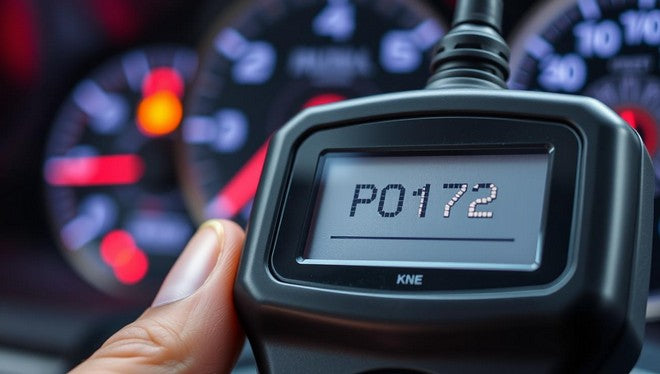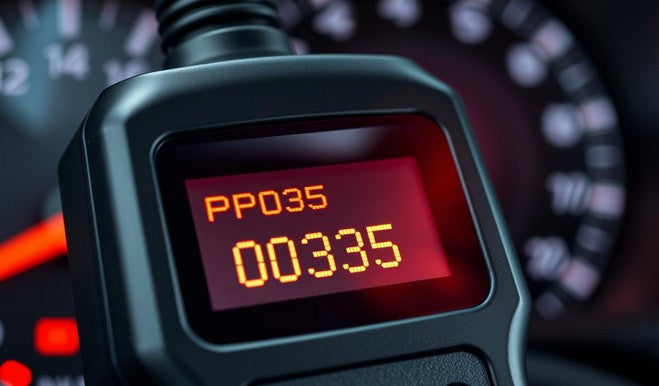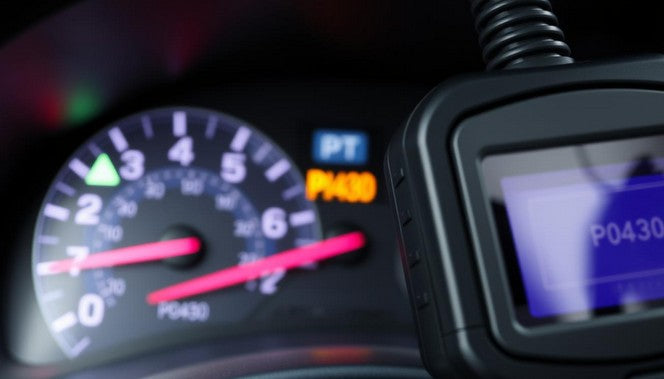When your check engine light illuminates and your OBD-II scanner reveals a P0172 code, your vehicle is telling you something important about its fuel system. This diagnostic trouble code indicates a "System Too Rich" condition in Bank 1 of your engine, meaning there's an imbalance in your air-fuel mixture that needs attention.
Understanding this code is crucial for maintaining your vehicle's performance, fuel economy, and emissions. In this comprehensive guide, we'll break down what the P0172 code means, its common causes, symptoms you might experience, and provide a step-by-step approach to diagnosis and repair.
What Does the P0172 Code Mean?
P0172 code indicates a rich fuel mixture condition in your engine
The P0172 code specifically means "System Too Rich (Bank 1)" in your vehicle's fuel system. In simple terms, your engine is receiving too much fuel relative to the amount of air in the combustion mixture. Bank 1 refers to the side of the engine that contains cylinder #1 (in V-shaped engines) or the entire cylinder bank in inline engines.
Modern vehicles maintain an optimal air-fuel ratio of approximately 14.7:1 (14.7 parts air to 1 part fuel) for ideal combustion. When this ratio contains excess fuel, the engine computer (PCM) detects this imbalance through oxygen sensors and sets the P0172 code.
This condition happens when the engine control module (ECM) has made significant negative fuel trim adjustments but still cannot maintain the proper air-fuel ratio. Understanding fuel trim is key to diagnosing this issue - it's how your vehicle's computer adjusts fuel delivery based on oxygen sensor feedback.
5 Most Common Causes of the P0172 Code
Several components in your fuel system can contribute to a rich condition. Here are the five most common causes of a P0172 code:
1. Faulty Mass Air Flow (MAF) Sensor
The MAF sensor measures the amount of air entering your engine. When it's dirty or malfunctioning, it may report lower airflow than what's actually entering the engine. This causes the PCM to inject too much fuel, creating a rich condition. Regular cleaning or replacement of this sensor often resolves the P0172 code.
2. Oxygen Sensor Issues
Oxygen sensors (also called O2 sensors or air-fuel ratio sensors) monitor the oxygen content in your exhaust to determine if the engine is running rich or lean. A faulty oxygen sensor may send incorrect signals to the PCM, causing it to adjust the fuel mixture incorrectly. These sensors naturally degrade over time and may need replacement.
3. Fuel Pressure Regulator Problems
A fuel pressure regulator maintains proper pressure in your fuel system. If it fails or gets stuck, it can allow excessive fuel pressure, forcing too much fuel through the injectors. A leaking regulator can also allow fuel to enter the vacuum line, creating a rich condition.
4. Leaking or Dirty Fuel Injectors
Fuel injectors deliver precise amounts of fuel into your engine. When they become clogged with deposits or develop leaks, they can deliver too much fuel or spray in an inefficient pattern. This directly contributes to a rich fuel mixture and can trigger the P0172 code.
5. Vacuum Leaks and PCV System Issues
The Positive Crankcase Ventilation (PCV) system and various vacuum lines help regulate airflow in your engine. Leaks or malfunctions in these components can disrupt the air-fuel balance. A stuck PCV valve or damaged vacuum lines can lead to improper fuel mixture and set off the P0172 code.
Symptoms You Might Experience with a P0172 Code
When your vehicle has a P0172 code, you may notice several symptoms that indicate a rich fuel mixture:
Performance Symptoms
- Rough or unstable idle
- Hesitation or stumbling during acceleration
- Reduced engine power
- Engine misfires or sputtering
- Difficulty starting the engine
Observable Symptoms
- Illuminated check engine light
- Black smoke from the exhaust
- Strong fuel smell from the exhaust
- Poor fuel economy
- Failed emissions test
The severity of these symptoms can vary depending on how rich the fuel mixture is and what's causing the condition. Some vehicles may exhibit all these symptoms, while others might only show a few or even just the check engine light.
Step-by-Step Diagnostic Process
Need Professional Diagnostic Help?
If you're not comfortable performing these diagnostic steps yourself, consider having a certified mechanic diagnose your P0172 code. Professional diagnosis can save you time and prevent potential mistakes.
Diagnosing a P0172 code requires a methodical approach and some specific tools. Follow these steps to identify the root cause:
Tools You'll Need
- OBD-II scanner with live data capability
- Digital multimeter
- Fuel pressure gauge
- MAF sensor cleaner
- Basic hand tools
- Vacuum gauge
- Smoke machine (optional)
- Inspection mirror
- Flashlight
Diagnostic Steps
-
Verify the Code and Check for Additional Codes
Use your OBD-II scanner to confirm the P0172 code and check for any related codes that might help pinpoint the issue. Pay special attention to oxygen sensor codes or misfire codes.
-
Check Fuel Trim Values
Using your scanner, examine the Short-Term Fuel Trim (STFT) and Long-Term Fuel Trim (LTFT) values. For a P0172 code, you'll typically see negative numbers (often -10% or lower), indicating the computer is reducing fuel to compensate for a rich condition.
-
Inspect the MAF Sensor
Remove and inspect the MAF sensor for dirt, oil, or debris. Clean it with a specialized MAF sensor cleaner (never use regular cleaners). After cleaning, recheck the code and fuel trim values.
-
Check for Vacuum Leaks
Inspect all vacuum hoses and the PCV system for leaks or damage. A smoke machine can help identify hard-to-find vacuum leaks. Pay special attention to the intake manifold gasket and PCV valve.
-
Test Fuel Pressure
Connect a fuel pressure gauge to test if the fuel pressure is within specifications. Excessive pressure can indicate a faulty fuel pressure regulator. Compare your readings to the manufacturer's specifications.
-
Inspect Oxygen Sensors
Check oxygen sensor readings using your scanner. A properly functioning O2 sensor should show fluctuating voltage between 0.1V and 0.9V. If the readings are consistently high or low, the sensor may be faulty.
-
Check Fuel Injectors
Perform a fuel injector balance test if your scanner supports this function. This can help identify leaking or clogged injectors. Significant variations between cylinders may indicate problematic injectors.
Repair Solutions and Estimated Costs
Once you've identified the cause of your P0172 code, here are the common repair solutions and their estimated costs:
|
Repair Solution |
Parts Cost |
Labor Cost |
Total Estimated Cost |
|
Clean/Replace MAF Sensor |
$15 (cleaner) - $300 (new sensor) |
$50 - $100 |
$65 - $400 |
|
Replace Oxygen Sensor |
$50 - $300 |
$50 - $150 |
$100 - $450 |
|
Replace Fuel Pressure Regulator |
$50 - $200 |
$100 - $250 |
$150 - $450 |
|
Clean/Replace Fuel Injectors |
$20 (cleaner) - $400 (new set) |
$100 - $300 |
$120 - $700 |
|
Replace PCV Valve |
$10 - $50 |
$50 - $100 |
$60 - $150 |
|
Repair Vacuum Leaks |
$10 - $100 |
$100 - $300 |
$110 - $400 |
Save on Diagnostic Tools
Looking to perform your own diagnostics? Quality OBD-II scanners with live data capabilities are available at competitive prices.
These costs can vary significantly depending on your vehicle make and model, your location, and whether you choose OEM or aftermarket parts. Luxury and European vehicles typically have higher parts and labor costs.
Prevention Tips for Fuel System Maintenance
Preventing a P0172 code is easier and less expensive than fixing it. Here are essential maintenance tips to keep your fuel system in optimal condition:
Regular Maintenance
- Replace the air filter every 15,000-30,000 miles to ensure proper airflow
- Use high-quality fuel from reputable stations to minimize contaminants
- Add fuel system cleaner every 3,000-5,000 miles to keep injectors clean
- Replace spark plugs according to manufacturer recommendations
- Inspect PCV valve during regular tune-ups and replace if necessary
Driving Habits
- Avoid frequent short trips that don't allow the engine to fully warm up
- Drive at highway speeds occasionally to help clean carbon deposits
- Don't ignore the check engine light when it first appears
- Allow your engine to reach operating temperature before heavy acceleration
- Maintain proper oil levels to prevent oil from entering the combustion chamber
Important: Some vehicles are more prone to P0172 codes due to design characteristics. European vehicles with direct injection systems often develop carbon buildup that can contribute to rich conditions. Regular carbon cleaning service every 60,000 miles can help prevent issues.
Frequently Asked Questions About P0172 Code
Is it safe to drive with a P0172 code?
While you can drive short distances with a P0172 code, it's not recommended for extended periods. A rich fuel mixture can damage your catalytic converter (an expensive repair), foul spark plugs, and significantly reduce fuel economy. It's best to address the issue promptly.
What does "Bank 1" mean in the P0172 code?
Bank 1 refers to the side of the engine that contains cylinder #1. In inline engines (4-cylinder, straight-6), there's only one bank. In V-shaped engines (V6, V8), Bank 1 is typically the side that includes the front cylinder according to the manufacturer's designation.
What's the difference between P0172 and P0175 codes?
Both codes indicate a rich fuel mixture condition, but P0172 refers to Bank 1 of the engine, while P0175 refers to Bank 2. If you have both codes simultaneously, the issue likely affects the entire engine rather than just one bank.
Can a dirty air filter cause a P0172 code?
Yes, a severely clogged air filter can restrict airflow to the engine, potentially causing a rich condition. However, it's usually not the only cause, as modern engines have sensors to detect reduced airflow and adjust fuel delivery accordingly.
What are fuel trims and how do they relate to the P0172 code?
Fuel trims are adjustments the engine computer makes to the base fuel delivery. Short-term fuel trim (STFT) makes immediate adjustments, while long-term fuel trim (LTFT) makes ongoing adjustments based on patterns. With a P0172 code, you'll typically see negative fuel trim values (often -10% or lower), indicating the computer is reducing fuel to compensate for a rich condition.
Can bad gas cause a P0172 code?
While rare, contaminated fuel can potentially contribute to a rich condition. However, it's unlikely to be the sole cause of a persistent P0172 code. If you suspect bad gas, try running the tank near empty and refilling with high-quality fuel from a different station.
Conclusion
The P0172 code indicates a rich fuel mixture condition that requires attention to prevent potential damage to your vehicle. By understanding the common causes, symptoms, and diagnostic process, you can either address the issue yourself or make informed decisions when seeking professional help.
Remember that proper fuel system maintenance is key to preventing this and other fuel-related issues. Regular service intervals, quality fuel, and addressing minor issues before they become major problems will help keep your vehicle running efficiently for years to come.




Leave a comment
This site is protected by hCaptcha and the hCaptcha Privacy Policy and Terms of Service apply.